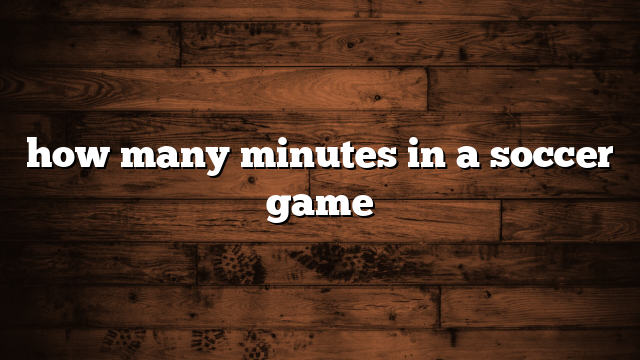How Many Minutes in a Soccer Game? Understanding the Time Structure of Soccer
Soccer, or football as it is known in many parts of the world, is a sport that captivates millions of fans globally. One of the most frequently asked questions by newcomers to the sport is, “How many minutes is a soccer game?” While the answer might seem straightforward, the intricacies of game duration and additional time considerations add depth to the understanding of soccer’s time structure. This comprehensive guide will explain the standard length of a soccer game, delve into stoppage time, extra time, and other relevant factors that affect the total duration of a match.
Standard Duration of a Soccer Game
Regulation Time
A standard soccer game consists of two halves, each lasting 45 minutes, making a total of 90 minutes of regulation play. This format is consistent across most levels of competitive soccer, including professional leagues, international competitions, and amateur matches. The 90-minute duration is designed to balance physical endurance with the quality of play, ensuring that both teams have ample opportunity to demonstrate their skills and strategies.
Halftime Interval
Between the two halves, there is a halftime interval lasting 15 minutes. This break allows players to rest, rehydrate, and receive tactical instructions from their coaches. For fans, it’s a moment to discuss the first half and anticipate the second, while broadcasters typically use this time for commercials and analysis.
Additional Time Considerations
Stoppage Time
In addition to the standard 90 minutes, referees often add extra time at the end of each half, known as stoppage or injury time. This compensates for any interruptions during the game, such as injuries, substitutions, and time-wasting tactics. The amount of stoppage time is at the referee’s discretion and is indicated by the fourth official at the end of each half.
Injury Time
Injuries can halt the flow of the game, requiring medical attention on the field. The time taken to address these incidents is added to stoppage time, ensuring that the total playing time remains as close to 90 minutes as possible.
Substitutions
Each team is allowed a certain number of substitutions per game (typically three, though this number has varied under certain circumstances, such as during the COVID-19 pandemic). The process of making substitutions can take time, especially if a player is slow to leave the field. This time is also included in stoppage time.
Time-Wasting
Time-wasting tactics, such as players taking excessive time for throw-ins, goal kicks, or free kicks, are monitored by referees. Any time lost due to these tactics is added to stoppage time to ensure fair play.
Extra Time and Penalty Shootouts
Knockout Stage Matches
In knockout stage matches, such as those in the World Cup, UEFA Champions League, and domestic cup competitions, a winner must be determined. If the match is tied at the end of regulation time, the game goes into extra time.
Extra Time Duration
Extra time consists of two halves of 15 minutes each, adding up to a total of 30 additional minutes. If the score is still tied after extra time, the match is typically decided by a penalty shootout.
Penalty Shootout
During a penalty shootout, each team selects five players to take penalty kicks, alternating between teams. If the scores remain tied after the initial five kicks, the shootout moves to sudden death, with each team taking one kick at a time until a winner is determined. While the penalty shootout itself doesn’t add a significant amount of playing time, it can extend the overall duration of the match.
Special Considerations
Youth and Amateur Matches
The duration of soccer games can vary significantly at the youth and amateur levels. Youth matches often have shorter halves, ranging from 20 to 40 minutes each, depending on the age group. Amateur matches may also have variations in game duration based on league rules and regulations.
Women’s Soccer
In women’s soccer, the game duration is typically the same as in men’s soccer, with two 45-minute halves and a 15-minute halftime interval. The same rules for stoppage time, extra time, and penalty shootouts apply.
Futsal and Small-Sided Games
Futsal, a variant of soccer played on a smaller, indoor pitch, features different time regulations. A standard futsal match consists of two 20-minute halves, with a 10-minute halftime interval. Small-sided games, such as 5-a-side or 7-a-side soccer, also have shorter durations, often ranging from 25 to 35 minutes per half.
Managing Game Time Effectively
Role of the Referee
The referee plays a crucial role in managing game time. They keep track of all stoppages and interruptions, ensuring that the appropriate amount of stoppage time is added at the end of each half. The referee’s decisions regarding time management are final and must be respected by players, coaches, and fans.
Team Strategies
Teams often develop strategies to manage game time effectively. For example, a team with a lead might adopt a more defensive approach and attempt to control possession to run down the clock. Conversely, a team trailing in the score might increase the pace of their play to maximize their scoring opportunities within the remaining time.
Conclusion
Understanding the duration of a soccer game involves more than just knowing that it lasts 90 minutes. The addition of stoppage time, the potential for extra time in knockout stages, and the unique regulations for various formats all contribute to the overall length of a match. By grasping these elements, fans and players alike can better appreciate the intricacies of game time management and the strategies employed by teams. Whether you’re watching a professional match or participating in a local league, knowing how long a soccer game lasts will enhance your overall experience and understanding of this beautiful sport.



